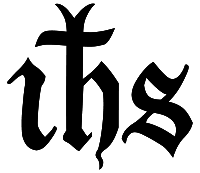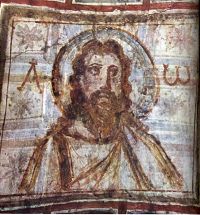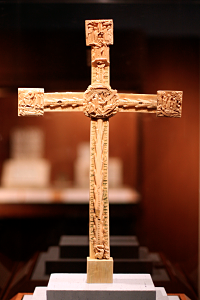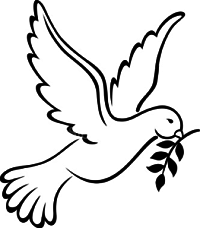A Guide to Christian Symbols
Have you ever stared at the back of a minvan, driven by a Christian family, and wondered to yourself (or possibly aloud to your companions), “What the heck is that fish design about?” Or perhaps you were dragged to a friend’s Lutheran church, and squinted at the pastor’s vestments which proudly and inscrutably proclaimed, “ihs” in squiggly letters. Even that cross hanging by a chain from the neck of your aunt or your girlfriend has a meaning, and you may be wondering what it is.
Well, wonder no more. I aim to help decipher the symbols and symbolism for you. I’ll start with that fish symbol, and add more items as they come to me or as I am asked about them.
The Fish symbol

This comes from a very ancient tradition in the early church, where it was used as a secret symbol by persecuted Christians. The Greek word in the center is "ichthys", which is the word for "fish" (as an example, this word carries into the scientific discipline of "ichthyology"). It is also an acronym for "Iesous Christos Theo Yios, Sōtēr" or, in English, "Jesus Christ, God's son, savior." It may be that the popularity stemmed from the fact that many of Jesus' disciples were fisherman, or perhaps due to the miracle of the feeding of 5000, with a few bread and fish, recorded in all the gospels. The fish symbol enjoyed a resurgence in the 1970s. For more information, Wikipedia has a decent overview here. The image is a public domain picture obtained from Pixabay.com.
"ihs", the Christ monogram

The letters "ihs" are a christogram, a symbol or monogram that derives from the first three letters of the Greek spelling of the name of Jesus: Iota-eta-sigma. These Greek monograms continued to be used in the Latin world (western Christendom) during the Middle Ages. See New Advent blog for an explanation. The image is from Wikimedia Commons.
Alpha and Omega

Sometimes vestments worn by clergy, stained glass windows, or carvings seen in churches will feature the greek letters for alpha and omega. This is a very early symbol, and derives from Revelation, in which John has a vision of Jesus, who says to him, "And, behold, I come quickly; and my reward is with me, to give every man according as his work shall be. I am Alpha and Omega, the beginning and the end, the first and the last." (Revelation 22: 12-13, King James Version). The image above is from early Christian artwork found in a catacomb (burial cave) which served as a secret meeting place of Christians during their time of persecution, and is from Wikimedia commons: Christ with beard". Licensed under Public Domain via Wikimedia Commons.
Cross / crucifix

The cross, of course, was the instrument of execution of Jesus of Nazareth. (Had his passion been centuries later, I wonder if we would be wearing miniature gallows, or if we would be displaying jeweled axes or stylized lethal injection syringes in our churches. But I digress). Tertullian referred to Christians as "devotees of the Cross" in 204, and described how followers would trace the sign of the cross on their foreheads. The earliest Christians, and modern Protestants, use a bare cross; the Crucifix (the cross including a figure of Christ) came into use in the Western Church in the 5th century. There are some variations of the cross, such as the "St. Andrews Cross", which according to tradition is the type of cross on which St. Andrew was executed. This is basically an "X", and is seen in some church symbols (for example, the logo of the Christian Church, Disciples of Christ), and has also been popular in flags (eg. North Carolina) and heraldric emblems.
The Dove, a symbol of the spirit

The dove became a popular symbol of the Holy Spirit in early Christian art, and was often depicted in association with baptism. The account of Jesus' Baptism in the Gospel according to St. Matthew mentions the descent of the spirit upon him as he came out of the waters: And when Jesus was baptized, immediately he went up from the water, and behold, the heavens were opened to him, and he saw the Spirit of God descending like a dove and coming to rest on him; and behold, a voice from heaven said, “This is my beloved Son, with whom I am well pleased.” (Matthew 3:16-17).
Of course, even further back in the Old Testament, the sign of the dove bearing an olive branch was the signal to Noah, that the Great Flood was over. The dove with olive branch has remained a generic symbol of peace and good will.